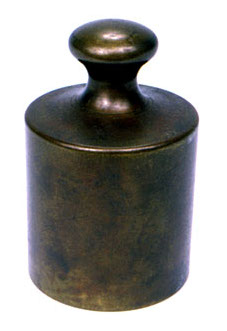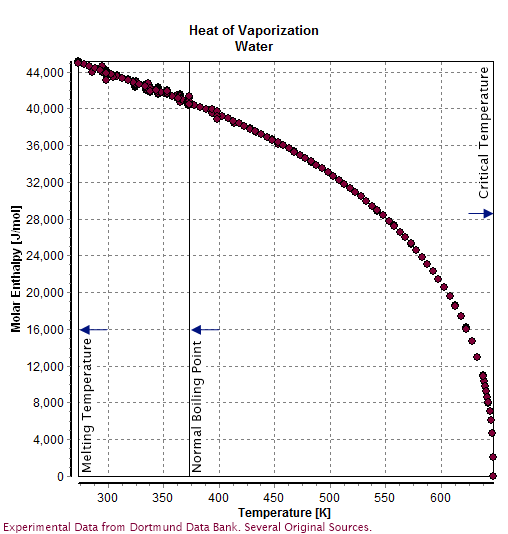|
Milligram
The kilogram (also spelled kilogramme) is the base unit of mass in the International System of Units (SI), equal to one thousand grams. It has the unit symbol kg. The word "kilogram" is formed from the combination of the metric prefix kilo- (meaning one thousand) and gram; it is colloquially shortened to "kilo" (plural "kilos"). The kilogram is an SI base unit, defined ultimately in terms of three defining constants of the SI, namely a specific transition frequency of the caesium-133 atom, the speed of light, and the Planck constant. A properly equipped metrology laboratory can calibrate a mass measurement instrument such as a Kibble balance as a primary standard for the kilogram mass. The kilogram was originally defined in 1795 during the French Revolution as the mass of one litre of water (originally at 0 °C, later changed to the temperature of its maximum density, approximately 4 °C). The current definition of a kilogram agrees with this original defini ... [...More Info...] [...Related Items...] OR: [Wikipedia] [Google] [Baidu] |
Pound (mass)
The pound or pound-mass is a unit of mass used in both the British imperial and United States customary systems of measurement. Various definitions have been used; the most common today is the international avoirdupois pound, which is legally defined as exactly , and which is divided into 16 avoirdupois ounces. The international standard symbol for the avoirdupois pound is lb; an alternative symbol (when there might otherwise be a risk of confusion with the pound-force) is lbm (for most pound definitions), # ( chiefly in the U.S.), and or ̶ (specifically for the apothecaries' pound). The unit is descended from the Roman (hence the symbol ''lb'', descended from the scribal abbreviation, '). The English word ''pound'' comes from the Roman ('the weight measured in '), and is cognate with, among others, German , Dutch , and Swedish . These units are now designated as historical and are no longer in common usage, being replaced by the metric system. Usage of the un ... [...More Info...] [...Related Items...] OR: [Wikipedia] [Google] [Baidu] |
Metric Prefix
A metric prefix is a unit prefix that precedes a basic unit of measure to indicate a multiple or submultiple of the unit. All metric prefixes used today are decadic. Each prefix has a unique symbol that is prepended to any unit symbol. The prefix '' kilo'', for example, may be added to ''gram'' to indicate ''multiplication'' by one thousand: one kilogram is equal to one thousand grams. The prefix '' milli'', likewise, may be added to ''metre'' to indicate ''division'' by one thousand; one millimetre is equal to one thousandth of a metre. Decimal multiplicative prefixes have been a feature of all forms of the metric system, with six of these dating back to the system's introduction in the 1790s. Metric prefixes have also been used with some non-metric units. The SI prefixes are metric prefixes that were standardised for use in the International System of Units (SI) by the International Bureau of Weights and Measures (BIPM) in resolutions dating from 1960 to 2022. Since 2009, t ... [...More Info...] [...Related Items...] OR: [Wikipedia] [Google] [Baidu] |
International System Of Units
The International System of Units, internationally known by the abbreviation SI (from French ), is the modern form of the metric system and the world's most widely used system of measurement. It is the only system of measurement with official status in nearly every country in the world, employed in science, technology, industry, and everyday commerce. The SI system is coordinated by the International Bureau of Weights and Measures, which is abbreviated BIPM from . The SI comprises a coherent system of units of measurement starting with seven base units, which are the second (symbol s, the unit of time), metre (m, length), kilogram (kg, mass), ampere (A, electric current), kelvin (K, thermodynamic temperature), mole (mol, amount of substance), and candela (cd, luminous intensity). The system can accommodate coherent units for an unlimited number of additional quantities. These are called coherent derived units, which can always be represented as products of powers of ... [...More Info...] [...Related Items...] OR: [Wikipedia] [Google] [Baidu] |
Second
The second (symbol: s) is a unit of time derived from the division of the day first into 24 hours, then to 60 minutes, and finally to 60 seconds each (24 × 60 × 60 = 86400). The current and formal definition in the International System of Units (SI) is more precise: The second ..is defined by taking the fixed numerical value of the caesium frequency, Δ''ν''Cs, the unperturbed ground-state hyperfine transition frequency of the caesium 133 atom, to be when expressed in the unit Hz, which is equal to s−1. This current definition was adopted in 1967 when it became feasible to define the second based on fundamental properties of nature with caesium clocks. As the speed of Earth's rotation varies and is slowing ever so slightly, a leap second is added at irregular intervals to civil time to keep clocks in sync with Earth's rotation. The definition that is based on of a rotation of the earth is still used by the Universal Time 1 (UT1) system. Etymology "Minute" ... [...More Info...] [...Related Items...] OR: [Wikipedia] [Google] [Baidu] |
Litre
The litre ( Commonwealth spelling) or liter ( American spelling) (SI symbols L and l, other symbol used: ℓ) is a metric unit of volume. It is equal to 1 cubic decimetre (dm3), 1000 cubic centimetres (cm3) or 0.001 cubic metres (m3). A cubic decimetre (or litre) occupies a volume of (see figure) and is thus equal to one-thousandth of a cubic metre. The original French metric system used the litre as a base unit. The word ''litre'' is derived from an older French unit, the '' litron'', whose name came from Byzantine Greek—where it was a unit of weight, not volume—via Late Medieval Latin, and which equalled approximately 0.831 litres. The litre was also used in several subsequent versions of the metric system and is accepted for use with the SI, despite it not being an SI unit The International System of Units, internationally known by the abbreviation SI (from French ), is the modern form of the metric system and the world's most widely used system of unit ... [...More Info...] [...Related Items...] OR: [Wikipedia] [Google] [Baidu] |
Imperial Units
The imperial system of units, imperial system or imperial units (also known as British Imperial or Exchequer Standards of 1826) is the system of units first defined in the British Weights and Measures Act 1824 and continued to be developed through a series of Weights and Measures Acts and amendments. The imperial system developed from earlier English units as did the Comparison of the imperial and US customary measurement systems, related but differing system of United States customary units, customary units of the United States. The imperial units replaced the Winchester measure, Winchester Standards, which were in effect from 1588 to 1825. The system came into official use across the British Empire in 1826. By the late 20th century, most nations of the former empire had metrication, officially adopted the metric system as their main system of measurement, but imperial units are still used alongside metric units in the United Kingdom and in some other parts of the former empi ... [...More Info...] [...Related Items...] OR: [Wikipedia] [Google] [Baidu] |
Grave (unit)
The grave (, ), abbreviated ''gv'', is the unit of mass used in the first metric system, which was implemented in France in 1793. In 1795, the grave was renamed as the kilogram. Origin The modern kilogram has its origins in the Age of Enlightenment and the French Revolution. In 1790 an influential proposal by Talleyrand called for a new system of units, including a unit of length derived from an invariable length in nature, and a unit of mass (then called ''weight'') equal to the mass of a unit volume of water. In 1791, the Commission of Weights and Measures, appointed by the French Academy of Sciences, chose one ten-millionth of the half meridian as the unit of length, and named it ''metre''. Initially a ''provisional'' value was used, based on the meridian measurement made in 1740 by Lacaille. In 1793 the commission defined the unit of mass as a cubic decimetre of distilled water at 0 °C, and gave it the name ''grave''. Two supplemental unit names, gravet (0.001 g ... [...More Info...] [...Related Items...] OR: [Wikipedia] [Google] [Baidu] |
Properties Of Water
Water () is a Chemical polarity, polar inorganic compound that is at room temperature a tasteless and odorless liquid, which is nearly colorless apart from Color of water, an inherent hint of blue. It is by far the most studied chemical compound and is described as the "universal solvent" and the "solvent of life". It is the most abundant substance on the surface of Earth and the only common substance to exist as a ice, solid, liquid, and water vapor, gas on Earth's surface. It is also the third most abundant molecule in the universe (behind Hydrogen, molecular hydrogen and carbon monoxide). Water molecules form hydrogen bonds with each other and are strongly polar. This polarity allows it to dissociate ions in salts and bond to other polar substances such as alcohols and acids, thus dissolving them. Its hydrogen bonding causes its many unique properties, such as having a solid form less dense than its liquid form, a relatively high boiling point of 100 °C for its molar ... [...More Info...] [...Related Items...] OR: [Wikipedia] [Google] [Baidu] |
Celsius
The degree Celsius is the unit of temperature on the Celsius temperature scale "Celsius temperature scale, also called centigrade temperature scale, scale based on 0 ° for the melting point of water and 100 ° for the boiling point of water at 1 atm pressure." (originally known as the centigrade scale outside Sweden), one of two temperature scales used in the International System of Units (SI), the other being the closely related Kelvin scale. The degree Celsius (symbol: °C) can refer to a specific point on the Celsius temperature scale or to a difference or range between two temperatures. It is named after the Swedish astronomer Anders Celsius (1701–1744), who proposed the first version of it in 1742. The unit was called ''centigrade'' in several languages (from the Latin ''centum'', which means 100, and ''gradus'', which means steps) for many years. In 1948, the International Committee for Weights and Measures renamed it to honor Celsius and also to rem ... [...More Info...] [...Related Items...] OR: [Wikipedia] [Google] [Baidu] |
Parts Per Million
In science and engineering, the parts-per notation is a set of pseudo-units to describe the small values of miscellaneous dimensionless quantity, dimensionless quantities, e.g. mole fraction or mass fraction (chemistry), mass fraction. Since these fraction (mathematics), fractions are quantity-per-quantity measures, they are pure numbers with no associated units of measurement. Commonly used are * parts-per-million - ppm, * parts-per-billion - ppb, * parts-per-trillion - ppt, * parts-per-quadrillion - ppq, This notation is not part of the International System of Units - SI system and its meaning is ambiguous. Applications Parts-per notation is often used describing dilute solutions in chemistry, for instance, the relative abundance of dissolved minerals or pollutants in water. The quantity "1 ppm" can be used for a mass fraction if a water-borne pollutant is present at one-millionth of a gram per gram of sample solution. When working with aqueous solutions, it is ... [...More Info...] [...Related Items...] OR: [Wikipedia] [Google] [Baidu] |
Maximum Density
The maximum density of a substance is the highest attainable density of the substance under given conditions. Attaining maximum density Almost all known substances undergo thermal expansion in response to heating, meaning that a given mass of substance contracts to a low volume at low temperatures, when little thermal energy is present. Substances, especially fluids in which intermolecular forces are weak, also undergo compression upon the application of pressure. Nearly all substances therefore reach a density maximum at very low temperatures and very high pressures, characteristic properties of the solid state of matter. Water An especially notable irregular maximum density is that of water, which reaches a density peak at . This has important ramifications in Earth's ecosystem. References See also * List of elements by density * Density * Specific Gravity * Specific weight * Charge density * Buoyancy * Hydrometer A hydrometer or lactometer is an instrument us ... [...More Info...] [...Related Items...] OR: [Wikipedia] [Google] [Baidu] |




